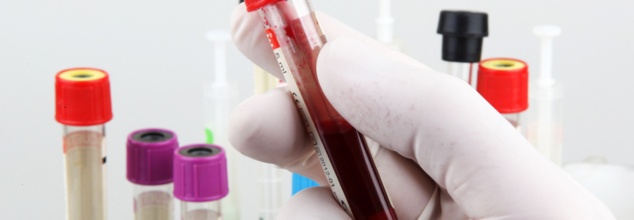- Health Conditions A-Z
- Health & Wellness
- Nutrition
- Fitness
- Health News
- Ayurveda
- Videos
- Medicine A-Z
- Parenting
A Blood Test For Irritable Bowel Syndrome Can Help Build A Better Diet

Diet plays a very important role when it comes to your health. There are many people who have to adhere to strict diets because of certain conditions they have. While the basic understanding that we need all kinds of foods to fulfill our body’s needs, sometimes these foods can also cause harm to your body. For example, lactose intolerant people cannot eat or consume any kind of dairy product as their bodies do not have the necessary compounds, known as lactose, to break down dairy foods. Similarly, there are many foods that may be ok for others to consume, but not for people who have digestive issues like IBS. But this new clinical trial may be able to help us know what food we can eat based on our blood test! The blood test, called inFoods IBS, looks for a special type of antibody in the blood. Antibodies are like tiny soldiers that our bodies make to fight off things that could make us sick.
IBS is a very common problem, affecting a large number of people. Many people know that what they eat can make their IBS symptoms worse, but it's often hard to figure out exactly which foods are the culprits. This is because everyone is different, and what triggers one person might not trigger another. Doctors hear from patients all the time, asking for help in determining which foods are causing their problems. So, finding a reliable way to pinpoint those foods is important. This test is attempting to provide that reliability.
How Does This Blood Test Work?
Basically, the test is looking for an antibody called IgG. When the gut reacts badly to a food, it makes more of this IgG antibody. The test checks for reactions to 18 common foods, like wheat, milk, and certain fruits. If the test finds high levels of the IgG antibody for a certain food, it means that food is likely causing problems. Therefore, the patient should try to remove that food from their diet.
Many people with IBS struggle to find relief from their stomach pain and discomfort. This new study looked at whether a special blood test could help. The idea was to see if the test could tell people which foods were making their IBS worse. The results were encouraging. When people changed their diets based on what the blood test showed, about 60% of them felt less stomach pain. This is better than the 42% who felt better when they just tried a general diet change. This shows that the blood test might be a useful tool for people with IBS to get real relief.
How Does This Personalized Nutrition Approach Work?
Many doctors suggest that people with IBS try elimination diets, where they cut out certain foods to see if their symptoms improve. However, these diets can be very hard to follow, because they often require people to cut out a lot of different foods. Doctors are always looking for ways to give patients care that's tailored to their specific needs. In the case of IBS, that means figuring out exactly which foods each person should avoid.
This blood test is a step in that direction. Experts are calling it a move towards "precision nutrition." This means that instead of giving everyone the same diet advice, doctors could use the blood test to create a personalized plan for each patient. While more research is needed, this test brings hope that doctors will soon be able to give much more precise dietary recommendations to those people that suffer from IBS. While this test is yet to be approved by FDA, it could be a world of comfort and ease for people who suffer with IBS.
Nebokitug Explained: Antibody Used To Treat A Rare Liver Disease

Credits: Canva
For people living with primary sclerosing cholangitis or PSC, medical options have always been painfully limited. Until now, there has been no approved drug that can slow the disease itself. Treatment has mostly meant managing symptoms and waiting, often for years, until a liver transplant becomes the only option. That is why new results around a monoclonal antibody called nebokitug are being seen as a turning point.
Researchers from the University of California Davis have reported promising findings from a Phase 2 clinical trial showing that nebokitug appears safe and may actually reduce liver inflammation and scarring. The study was published in the American Journal of Gastroenterology and has brought cautious optimism to both doctors and patients.
What Exactly Is PSC?
PSC is a rare, long-term liver disease that mainly affects the bile ducts. These ducts act like tiny pipelines that carry bile from the liver to the small intestine, where it helps digest fats. In PSC, these ducts become inflamed, damaged, and scarred over time. As they narrow, bile starts backing up in the liver, slowly causing liver injury.
Many people with PSC also have inflammatory bowel disease, especially ulcerative colitis. This strong link has led researchers to believe that ongoing gut inflammation may trigger immune reactions that damage the liver as well. Symptoms can range from extreme tiredness and itching to yellowing of the skin and eyes. Some patients have no symptoms at all in the early stages, which makes the disease harder to catch.
Why Treatment Has Been So Difficult
One of the biggest challenges with PSC is that doctors have not had a way to stop the scarring process itself. Once fibrosis sets in, it slowly progresses and increases the risk of liver failure and bile duct cancer. While medications can help with itching or infections, they do not change the course of the disease. This gap in treatment is what makes the nebokitug study so important.
How Nebokitug Works
Nebokitug is a lab-made antibody designed to block a protein called CCL24. This protein plays a key role in driving inflammation and fibrosis in the liver. In people with PSC, CCL24 levels are higher than normal and are found around the bile ducts where damage is most severe.
By blocking CCL24, nebokitug aims to calm the immune response and slow down the scarring process. Earlier lab and animal studies suggested this approach could work. The new trial is one of the first to test this idea in people with PSC.
What the Trial Found
The Phase 2 study included 76 patients from five countries. Participants received either one of two doses of nebokitug or a placebo through an IV every three weeks for 15 weeks. The main goal was to check safety, since this was still an early-stage trial.
The results were encouraging. Nebokitug was found to be safe and well tolerated. More importantly, patients who already had more advanced liver scarring showed improvements in liver stiffness and markers linked to fibrosis when compared to those on placebo. These changes suggest that the drug may be doing more than just easing symptoms.
Experts involved in the study say these findings could change the future of PSC care. Reducing inflammation and fibrosis could slow disease progression and delay or even prevent the need for a transplant in some patients. While larger trials are still needed, nebokitug represents one of the strongest signals yet that PSC may finally have a disease-modifying treatment on the horizon.
Can Drinking Beer Cause Cancer? A New Study Says There Is No Safe Limits

Credits: Canva
Now, drinking beer too could increase the risk of mouth cancer. On Tuesday, researchers at the Tata Memorial Centre (TMC) reported this adding new evidence. They found a 59 per cent higher risk of mouth cancer in people who drank, on average, just two grams of alcohol from beer daily, compared with those who did not drink. The research suggests that there may not be any safe limit to drink.
What Did The Study Reveal About Beer And Cancer?
Their study in India's large scale analysis that probs link between alcohol and cancer of the buccal mucosa. This is the pink lining of cheeks and lips. In India, this kind of cancer is the second most common malignancy in India after breast cancer. It also leads to 1,40,000 new cases and nearly 80,000 deaths each year.
Who Are More Prone To Buccal Mucosa Cancer?
People who consume more than one glass of alcohol a day and chew tobacco on a day to day basis are five times more at risk of developing this cancer as compared to those who do not drink or chew tobacco.
The findings of the study was published in the journal BMJ Global Health and it suggests that joint use of both, alcohol and tobacco leads to 62 per cent of all buccal mucosa cancer in the country.
As Telegraph reported, Tata Memorial Centre for Cancer Epidemiology unit's head of molecular epidemiology and population genomics unit Sharayu Mhatre said, "We see an unmistakable pattern: the more alcohol people drink, the greater their risk of buccal mucosal cancer."
Buccal mucosal cancer continues to pose a serious public health challenge in India. Among 100 patients diagnosed with locally advanced stages of the disease, 57 die within five years, a mortality rate that experts say highlights the urgent need for prevention, early detection, and stronger regulation of risk factors.
Alcohol Emerges as a Major Risk Factor
While the link between alcohol and cancer is well known, new findings reinforce just how dangerous alcohol consumption can be for oral health. Researchers found that people who consumed alcohol had a 68% higher risk of developing buccal mucosal cancer compared to non-drinkers.
What stood out most was the type of alcohol consumed. Unregulated, locally brewed liquor carried the highest risk, increasing cancer likelihood by 87%, compared to 72% among consumers of regulated, commercially sold drinks. Experts point out that these local brews often contain significantly higher ethanol concentrations and lack quality control.
Not Just Heavy Drinking—Even Small Amounts Matter
The study analyzed drinking patterns among over 3,700 participants, comparing cancer patients with healthy individuals. Alcohol types ranged from beer and spirits like whisky and vodka to traditional local drinks such as bangla and tharra. Ethanol levels varied widely—from 5% in beer to as high as 90% in some locally distilled spirits.
Alarmingly, increased cancer risk was seen even at low levels of alcohol intake. As little as two grams of alcohol a day from beer, or roughly one glass of stronger liquor, was enough to raise concern.
Alcohol and Tobacco: A Dangerous Combination
The risk escalates dramatically when alcohol use is combined with tobacco chewing. Tobacco alone raised cancer risk by 200%, alcohol alone by 76%, but together, the risk shot up to 346%. Researchers explain that alcohol may damage the mouth’s protective lining, making it easier for tobacco-related carcinogens to penetrate and cause harm.
Health experts stress that these findings underline the need for greater public awareness, stricter monitoring of locally brewed alcohol, and stronger prevention strategies. The World Health Organization has already warned that no level of alcohol is safe, noting that even light or moderate drinking contributes to a significant number of alcohol-related cancers globally.
For India, where oral cancers remain widespread, these insights serve as a critical reminder: everyday habits can have life-altering consequences.
Delhi Sees Some Relief From Toxic Air; GRAP IV Removed, 'Will Bring Down Pollution In 5 Years,' Says Nitin Gadkari

Credits: iStock
Delhi finds itself in a little relief as the AQI of the city has dropped to 221 as per the CAQM. GRAP IV restrictions have also been lifted, however, pollution and smog continues to take over the city. The Meteorological Department has issued a yellow alert for the next few days, which could affect road and air traffic.
While GRAP IV is now removed, measures under GRAP I, II, and III will continue. As per the IMD forecast, this is what could happen for the next 5 days in Delhi
- December 26: Dense fog will prevail in the morning. Visibility is likely to be low.
- December 27: Yellow alert, dense fog in the morning and afternoon.
- December 28: Yellow alert, moderate to dense fog expected in the early morning.
- December 29-30: Fog will reduce slightly, but moderate haze will prevail in the morning.
Union Transport Minister On Delhi's Pollution
Nitin Gadkari, Union Minister of Road Transport and Highways also highlighted the alarming conditions of Delhi's smog and pollution. He said, "I stay for hardly two days in Delhi, and get an infection," as he spoke on how pollution impacts one's health conditions. However, he did speak on the severity of pollution and highlighted how the transport sector could play a huge role to bring relief to Delhi.
He highlighted that fuel combustion and transport emission leads to most of Delhi pollution.
In an interview with the news agency ANI, the minister also said that his ministry and Central Government are working on several projects and initiatives that will free Delhi from air pollution in the next five years.
Gadkari stated that the Ministry of Road Transport and Highways is undertaking projects worth Rs 1 lakh crore in Delhi to ease traffic congestion. He stated that all these efforts will not only help free Delhi of air pollution but also reduce the country's imports, increase job opportunities, and help farmers.
Electric Buses, Cars, and Scooters
The minister highlighted that 40% of the air pollution in the National Capital region is due to the burning of fossil fuels. In this regard, the government introduced electric buses in the city and enabled automakers to introduce electric cars and two-wheelers in the country.
He further stated that alternate fuel vehicles, such as those that run on CNG, LPG, and flex fuels (E20), are also being introduced and that all these efforts combined will reduce the city's pollution levels.
CNG And Bitumin From Rice Straw
Gadkari pointed out that nearly 200 lakh tonnes of rice straw or parali is burnt in Haryana and Punjab, a major cause of air pollution in the Delhi-NCR region. In this regard, the government is setting up 400 plants to convert the rice straw into CNG. At the moment, 60 plants are operational.
The minister also discussed a new project in Panipat in which rice straw is being used to create 1 lakh litres of Ethanol, 1.5 tonnes of bitumen, and 78,000 tonnes of jet fuel.
© 2024 Bennett, Coleman & Company Limited

